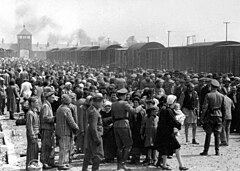
Back Holocaust Afrikaans Völkermord an den europäischen Juden ALS ሆሎኮስት Amharic Holocausto AN Eallbærnet ANG यहूदी अग्निकांड ANP الإبادة النازية لليهود Arabic ܩܛܠܥܡܐ ܝܗܘܕܝܐ ARC هولوكوست ARZ ইহুদী গণহত্যা Assamese
| The Holocaust | |
|---|---|
| Part of World War II | |
 Jews arriving at Auschwitz II in German-occupied Poland, May 1944. Most were selected to go to the gas chambers. | |
| Location | Europe, primarily German-occupied Poland and the Soviet Union |
| Date | 1941–1945 |
Attack type | Genocide, ethnic cleansing, mass murder, mass shooting, death marches, poison gas, hate crime |
| Deaths | Around 6 million Jews |
| Perpetrators | Nazi Germany along with its collaborators and allies |
The Holocaust, (/ˈhɒləkɔːst/ ⓘ)[1] known in Hebrew as the Shoah (שואה), was the genocide of European Jews during World War II. Between 1941 and 1945, Nazi Germany and its collaborators systematically murdered some six million Jews across German-occupied Europe, around two-thirds of Europe's Jewish population. The murders were carried out primarily through mass shootings and poison gas in extermination camps, chiefly Auschwitz-Birkenau, Treblinka, Belzec, Sobibor, and Chełmno in occupied Poland. Separate Nazi persecutions killed a similar or larger number of non-Jewish civilians and prisoners of war (POWs); the term Holocaust is sometimes used to encompass also the persecution of these other groups.
The Nazis developed their ideology based on racism and pursuit of "living space", and seized power in early 1933. Meant to force all German Jews to emigrate, regardless of means, the regime passed anti-Jewish laws, encouraged harassment, and orchestrated a nationwide pogrom in November 1938. After Germany invaded Poland in September 1939, occupation authorities began to establish ghettos to segregate Jews. Following the June 1941 invasion of the Soviet Union, 1.5 to 2 million Jews were shot by German forces and local collaborators. By early 1942, the Nazis decided to murder all Jews in Europe. Victims were deported to extermination camps where they were killed with poisonous gas if survived, while others were sent to forced labor camps where many died from starvation, abuse, exhaustion, or being used as test subjects in experiments. Property belonging to murdered Jews were redistributed to the German occupiers and other non-Jews. Although the majority of Holocaust victims died in 1942, the killing continued until the end of the war in May 1945.
Many Jewish survivors emigrated out of Europe after the war. A few Holocaust perpetrators faced criminal trials. Billions of dollars in reparations have been paid, although falling short of the Jews' losses. The Holocaust has also been commemorated in museums, memorials, and culture. It has become central to Western historical consciousness as a symbol of the ultimate human evil.
- ^ Wells, John C. (2008). Longman Pronunciation Dictionary (3rd ed.). Longman. ISBN 978-1-4058-8118-0.